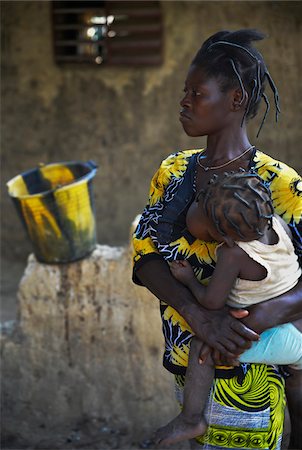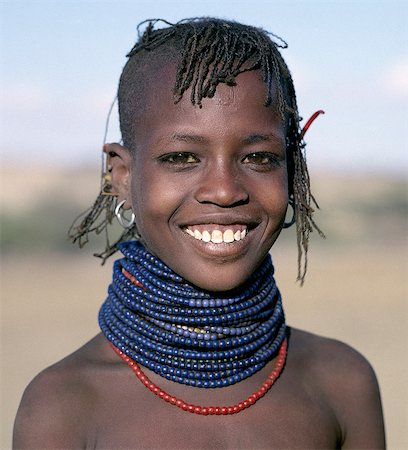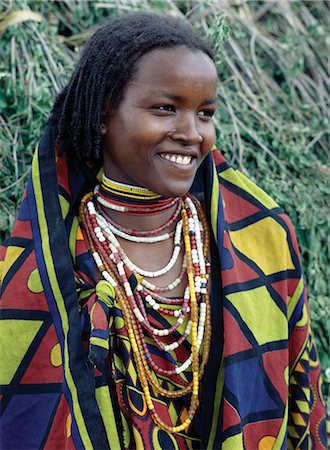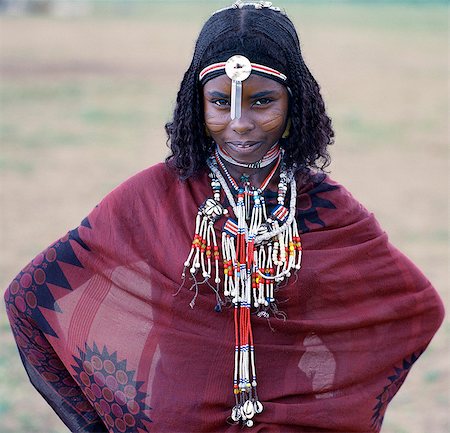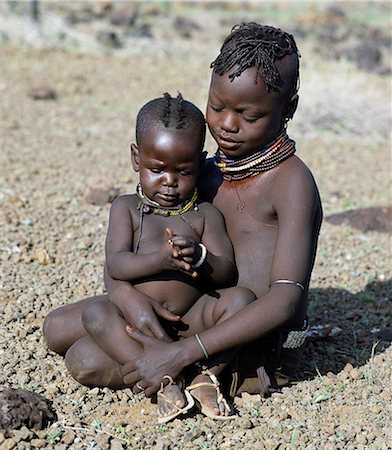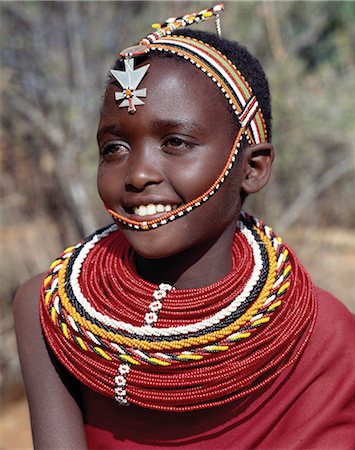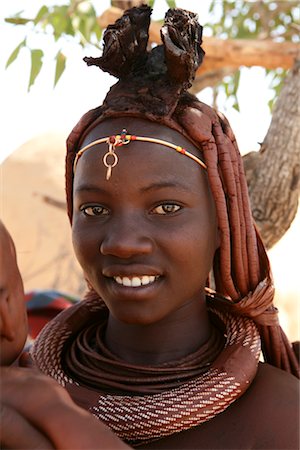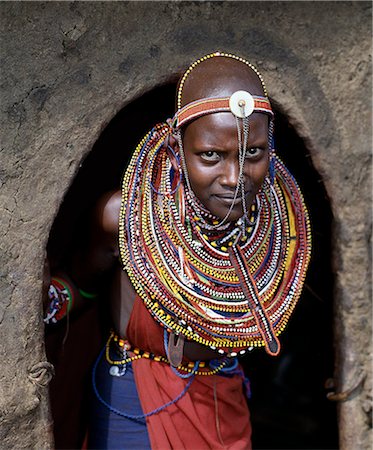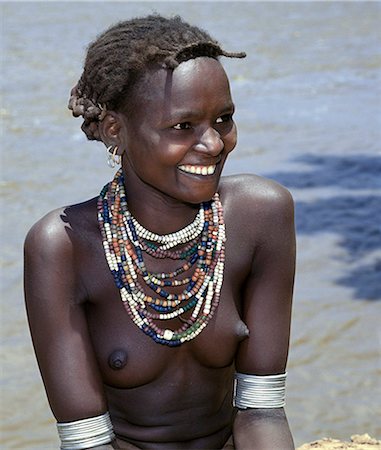-
Portrait of girl carrying sandals on her head, near Gaoua, Poni Province, Burkina Faso
Rights-Managed
-
An Afar girl has tribal scarification on her cheeks. Scarification is practiced in only a few sections of her tribe. Proud and fiercely independent,the nomadic Afar people live in the low-lying deserts of Eastern Ethiopia.
Rights-Managed
-
Mother holding child in arms while nursing, black and yellow patterns, Gaoua, Poni Province, Burkina Faso
Rights-Managed
-
Portrait of Himba woman, showing hairstyle of Himba women, Kaokoveld, Namibia, Africa
Rights-Managed
-
A pretty young Turkana girl has already had the flesh below her lower lip pierced in readiness for a brass ornament after her marriage. The rims of her ears have also been pierced and the holes kept open with small wooden sticks.
Rights-Managed
-
A pretty Borana girl at Mega in southern Ethiopia wears brightly coloured cotton cloth and numerous strings of beads. The pastoral Borana live either side of the southern Ethiopian/northern Kenya border and form a large and important group of the Oromo-speaking cluster of tribes.
Rights-Managed
-
A Turkana girl in all her finery. Among the Turkana,cicatrization is a common form of beautification. She wears a crucifix given to her by a missionary; they are popular ornaments despite not necessarily being associated with Christianity.
Rights-Managed
-
A Dassanech girl braids her sister's hair at her village in the Omo Delta. Much the largest of the tribes in the Omo Valley numbering around 50,000,the Dassanech (also known as the Galeb,Changila or Merille) and Nilotic pastoralists and agriculturalists.
Rights-Managed
-
Red Ochre (or ocher stone) pigment used by Himba to create a reddish tint, Kaokoveld, Namibia, Africa
Rights-Managed
-
A Giriama girl from Kenya's Coast Province carrying a gourd full of water on her head. Her small skirt is made from strips of printed cotton material.
Rights-Managed
-
Two Turkana girls set off to fetch water from a nearby Waterhole. Their water containers are made of wood by the women of the tribe. Their 'V' shaped aprons are made of goatskin and have been edged with hundreds and hundreds of round discs fashioned out of ostrich eggshells.
Rights-Managed
-
A young Turkana girl adorned with necklaces of a style the Southern Turkana prefer to wear.
Rights-Managed
-
An attractive girl from the Kediyo tribe carries a large,beautifully made umbrella. Its wooden frame is covered with the dried leaves of ensete,the false banana plant (seen growing in the background). Widely cultivated in southern Ethiopia,ensete roots and stems,which are rich in carbohydrates,are either cooked and eaten as a porridge or made into bread.
Rights-Managed
-
A young Afar girl at Filwoha in the Awash National Park. Filwoha in the Afar language means 'hot water'. The beautiful springs are surrounded by doum palms and rise from deep underground at about 96.8 degrees F.
Rights-Managed
-
A pretty tousle-haired girl of the nomadic Afar tribe wears bright colours in stark contrast to the drab,windswept surroundings of Lake Abbe.
Rights-Managed
-
Maasai girls gather to celebrate a wedding. Their broad beaded necklaces with predominantly white glass beads mark then as Kisongo Maasai,the largest clan group of the tribe which lives either side of the Kenya-Tanzania border.
Rights-Managed
-
An Afar girl with braided hair has very noticeable scarification on her cheeks. Scarification is practiced in only a few sections of her tribe. Proud and fiercely independent,the nomadic Afar people live in the low-lying deserts of Eastern Ethiopia.
Rights-Managed
-
Samburu girls are given strings of beads by their fathers when they are still young. As soon as they are old enough to have lovers from the warrior age set, they regularly receive gifts from them.Over a period of years, their necklaces can smother them up to their necks.
Rights-Managed
-
A Turkana woman makes the final ties to the dome-shaped framework of her home. In wet weather,hides will be laid on top and secured with leather thongs.
Rights-Managed
-
A Maasai girl from the Kisongo clan wearing an attractive beaded headband.
Rights-Managed
-
A Samburu woman resplendent in her beaded necklaces and numerous bracelets makes best use of a large rainwater pond to wash herself. Water is scarce in much of Samburuland.
Rights-Managed
-
Childhood is brief in nomadic communities. From an early age,Turkana girls help their mothers with the household chores and look after their younger brothers and sisters during the day. The baby has wooden charms round her neck to ward off evil spirits.
Rights-Managed
-
A Maasai woman wearing a very fine beaded necklace. The predominant white colour of her glass beadwork marks her as a Kisingo Maasai,the largest clan group of her tribe living either side of the Kenya-Tanzania border.
Rights-Managed
-
A Turkana girl with a large gourd-like container used as a receptacle for water or milk. In the absence of gourds,the Turkana carve their containers from soft wood,such as that from the common commiphora species,which thrives in semi-arid country.
Rights-Managed
-
A young Datoga man tends his family's livestock on the plains east of Lake Manyara in Northern Tanzania.The Datoga (known to their Maasai neighbours as the Mang'ati and to the Iraqw as Babaraig) live in northern Tanzania and are primarily pastoralists..
Rights-Managed
-
An Afar girl has her attractive hairstyle embellished with buttons and beads,which is typical of the young girls of her tribe. Proud and fiercely independent,the nomadic Afar people live in the low-lying deserts of Eastern Ethiopia.
Rights-Managed
-
The fetching hairstyle of a young Afar girl. Proud and fiercely independent,the nomadic Afar people live in the low-lying deserts of Eastern Ethiopia.
Rights-Managed
-
Two Giriama girls pound corn outside their home using a large wooden mortar and pestles. Their small skirts are made from strips of printed cotton material - a traditional dress of Giriama women and children.
Rights-Managed
-
Pokot women and girls dancing to celebrate an Atelo ceremony. The Pokot are pastoralists speaking a Southern Nilotic language.
Rights-Managed
-
Young Maasai girls decorate their faces with ochre and clay in preparation for a dance.
Rights-Managed
-
A young Pokot girl wearing a traditional broad necklace made of hollow reed grass that denotes her uninitiated status. The Pokot are pastoralists speaking a Southern Nilotic language.
Rights-Managed
-
Two young Karo girls stand in front of the massive trunk of a fig tree. A small Omotic tribe related to the Hamar,who live along the banks of the Omo River in southwestern Ethiopia,the Karo are renowned for their elaborate body painting using white chalk,crushed rock and other natural pigments.
Rights-Managed
-
Kenya, Samburu District. Young Samburu girl in traditional beaded necklaces.
Rights-Managed
-
Song is an art form ingrained in Turkana culture. At the end of a dance session,the participants invariably enjoy the Song of the Bulls. Each young man will take centre-stage to extol the praises of his favourite ox. He will explain how it came into his possession,its distinguishing traits and with outstretched arms,imitate the shape of its horns.
Rights-Managed
-
A young Maasai girl wears a headband decorated with chains and cowrie shells that signifies her recent circumcision. Clitodectomy was commonly practiced by the Maasai but it is now gradually dying out.
Rights-Managed
-
A Nyangatom woman grinds sorghum using two stones. Typical of her tribe,she wears a heavily beaded calfskin skirt,multiple layers of bead necklaces and metal bracelets and amulets. The Nyangatom or Bume are a Nilotic tribe of semi-nomadic pastoralists who live along the banks of the Omo River in south-western Ethiopia.
Rights-Managed
-
During Samburu wedding celebrations,warriors resplendent with long Ochred braids dance with young girls who have put on all their finery for the occasion. Both warriors and girls smear their faces,necks and shoulders with red ochre mixed with animal fat to enhance their appearance. Two spears are tipped with ostrich-feather pompoms.
Rights-Managed
-
A young Maasai girl wearing a wooden plug in her pierced ear to elongate the earlobe. It has been a tradition of the Maasai for both men and women to pierce their ears and elongate their lobes for decorative purposes. Her two lower incisors have been removed - a common practice that may have resulted from an outbreak of lockjaw a long time ago.
Rights-Managed
-
A young Samburu girl dances during a wedding celebration. By arching her back and thrusting out her chest,she flicks her beaded necklaces up and down while dancing silently to the songs of the warriors. Her body and necklace have been smeared with red ochre,and her eyebrows blackened with charcoal dust mixed with animal fat.
Rights-Managed
-
Young Samburu girls dance during a wedding celebration. By arching their backs and thrusting out their chests,they flick their beaded necklaces up and down while dancing silently to the songs of the warriors. Their bodies and necklaces have been smeared with red ochre.
Rights-Managed
-
A Maasai girl in traditional attire. The predominant white colour of her beadwork and the circular scar on her cheek denote that she is from the Kisongo section of the Maasai,the largest clan group,which lives either side of the border in Kenya and Tanzania.
Rights-Managed
-
A young Dassanech girl holds her little brother. She wears a leather skirt with an elaborate fringe of wooden and metal tassles. Much the largest of the tribes in the Omo Valley numbering around 50,000,the Dassanech (also known as the Galeb,Changila or Merille) are Nilotic pastoralists and agriculturalists.
Rights-Managed
-
During Samburu wedding celebrations,married women congregate apart from the warriors and young girls to sing in praise of the couple and to dance.
Rights-Managed
-
A Nyangatom girl weaves a grass basket. The Nyangatom or Bume are a Nilotic tribe of semi-nomadic pastoralists who live along the banks of the Omo River in south-western Ethiopia.
Rights-Managed
-
In the semi-arid terrain of Turkanaland,women have to travel great distances to collect firewood. Like other Nilotic people,Turkana women balance heavy loads on their heads with graceful carriage and poise. The attire of this woman is typical of married women in the tribe.
Rights-Managed
-
A close-up of a Pokot woman's earrings,hairstyle and beaded ornaments. Only married women wear brass earrings and glass-beaded collars. The band over her head supports the weight of her heavy earrings.
Rights-Managed
-
In the early morning,young Samburu girls take kids to their mothers. They will then milk the nanny goats leaving half the milk for the kids. Only women and children milk goats although every member of the family will drink the milk.
Rights-Managed
-
Pokot women and girls dancing to celebrate an Atelo ceremony. The Pokot are pastoralists speaking a Southern Nilotic language.
Rights-Managed
-
A jovial group of Turkana girls in traditional attire. Their aprons are made of goatskin,either beaded or cut into thin strips before braiding. The two girls in the middle have already had the flesh below their lower lips pierced in readiness for a brass ornament after marriage.
Rights-Managed
-
During Samburu wedding celebrations,married women congregate apart from the warriors and young girls to sing in praise of the couple and to dance.
Rights-Managed
-
A Maasai girl from the Kisongo clan wearing an attractive beaded headband and necklace.
Rights-Managed
-
Song is an art form ingrained in Turkana culture. After months of separation,young men and girls gather together during the rains when grass is abundant and life is relatively easy for a while. The Turkana have a rich repertoire of at least twenty dances,most of which are quite energetic.
Rights-Managed
-
Samburu girls are given strings of beads by their fathers when they are still young. As soon as they are old enough to have lovers from the warrior age-set,they regularly receive gifts from them. Over a period of years,their necklaces can smother them up to their necks. The metal cross-like ornament hanging from the girl's headband has no religious significance.
Rights-Managed
-
The decorated leather apron or skirt of a young Nyangatom girl. The numerous white discs woven into the strands of braided leather are made of ostrich shell.The Nyangatom are one of the largest tribes and arguably the most warlike people living along the Omo River in Southwest Ethiopia.
Rights-Managed
-
Two jovial Pokot girls set off with leather bags in search of edible berries. Pokot girls and women traditionally wore leather skirts and capes made from home-tanned goatskins. The necklaces of young girls are made from small segments of sedge grass.
Rights-Managed
-
Turkana girls return home from a Waterhole with water containers made of wood. Their cloaks are goatskin embellished with glass beads.
Rights-Managed
-
A young Maasai girl in all her finery pauses at the entrance to her mother's home. The wall and roof of the house are plastered with a mixture of cow dung and soil.
Rights-Managed
-
In the early morning,a young Samburu girl takes a kid to its mother. She will then milk the nanny goat leaving half the milk for the kid. Only women and children milk goats although every member of the family will drink the milk.
Rights-Managed
-
The Pokot have a small ceremony called Koyogho when a man pays his in-laws the balance of the agreed dowry for his wife. At the conclusion of the ritual, his wife is given a large gourd of milk which she carries home on her back with her youngest child.
Rights-Managed
-
Samburu girls are given strings of beads by their fathers when they are still young. As soon as they are old enough to have lovers from the warrior age-set,they regularly receive gifts from them. Over a period of years,their necklaces can smother them up to their necks. The metal cross-like ornament hanging from the girl's headband has no religious significance.
Rights-Managed
-
A Hadza girl wearing a beaded headband and necklaces.The Hadzabe are a thousand-strong community of hunter-gatherers who have lived in the Lake Eyasi basin for centuries. They are one of only four or five societies in the world that still earn a living primarily from wild resources.
Rights-Managed
-
In the early morning,a Maasai herdsboy and his sister drive their family's flock of sheep across the friable,dusty plains near Malambo in northern Tanzania.
Rights-Managed
-
A Samburu woman wearing a mporro necklace, which denotes her married status. These necklaces were once made of hair from giraffe tails but nowadays, the fibres of doum palm fronds, Hyphaene coriacea, are used instead.The red beads after which the necklace is named are wound glass beads made in Venice c.1850.
Rights-Managed
-
A Samburu Warrior drives his goats along the wide,sandy seasonal watercourse of the Milgis where waterholes dug by the Samburu in the dry season are a lifeline for pastoralists in this semi-arid region of their district.
Rights-Managed
-
A young Daasanech girl beside the Omo River. Her hairstyle, necklaces and metal armbands are typical of her tribe.The Dassanech people live in the Omo Delta of southwest Ethiopia, one of the largest inland deltas in the world.
Rights-Managed
-
Gabbra women sing and dance to celebrate a wedding. The traditional metal ornamentation on their heads is called malmal.
Rights-Managed
-
Turkana women and girls are responsible for watering livestock,which is unusual among pastoral societies. Here,a young girl waters goats from a waterhole dug in the sand of a seasonal watercourse. Her young brother will control the flow of stock to the water trough. In the background,a man digs out another waterhole; they have to been deepened regularly towards the end of the dry season.
Rights-Managed
-
Gabbra women sing and dance to celebrate a wedding. The traditional metal ornamentation on their heads is called malmal.
Rights-Managed
-
A young Maasai girl wears face paint and numerous beaded ornaments in preparation for a dance with warriors.
Rights-Managed
-
A Hadza woman digs for edible tubers with a digging stick.The Hadzabe are a thousand-strong community of hunter-gatherers who have lived in the Lake Eyasi basin for centuries. They are one of only four or five societies in the world that still earn a living primarily from wild resources.
Rights-Managed
-
Maasai girls in all their finery and with bells tied round their legs wait at the entrance to a house before dancing with warriors.
Rights-Managed
-
A proud Turkana father and his young daughter. Both their hairstyles are typical of tribal custom in the west of Turkanaland.
Rights-Managed
-
A Samburu woman wearing a mporro necklace,which signifies her married status.These necklaces,once made of hair from giraffe tails,are now made from fibres of doum palm fronds (Hyphaene coriacea). The beads are mid-19th century Venetian glass beads,which were introduced to Samburuland by early hunters and traders.
Rights-Managed
-
Song is an art form ingrained in Turkana culture. At the end of a dance session,the participants invariably enjoy the Song of the Bulls. Each young man will take centre-stage to extol the praises of his favourite ox. He will explain how it came into his possession,its distinguishing traits and with outstretched arms,imitate the shape of its horns.
Rights-Managed



